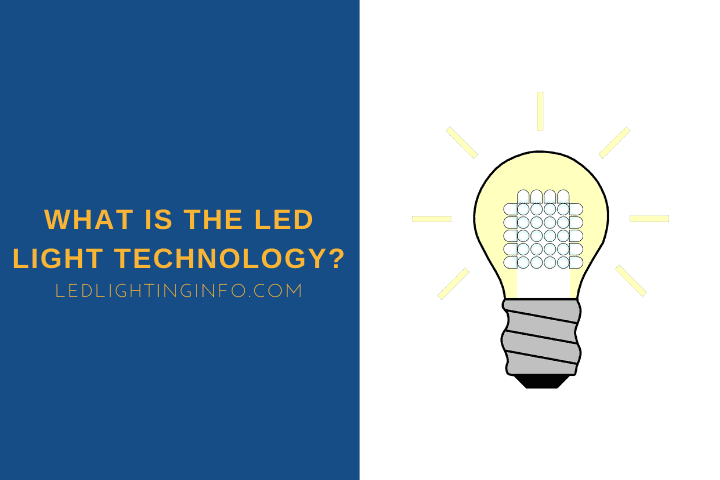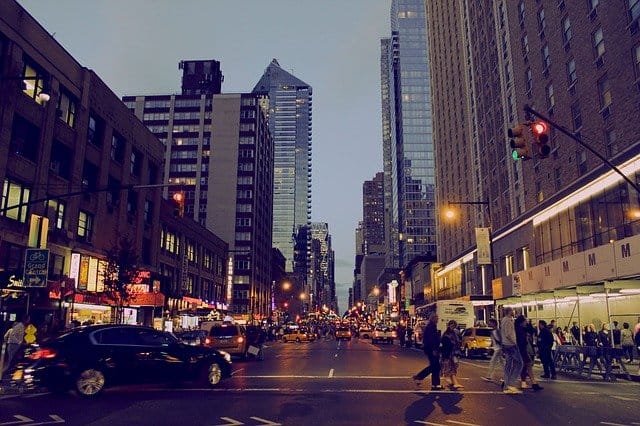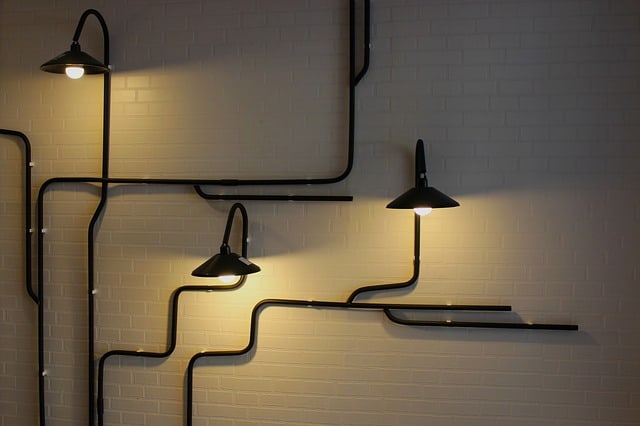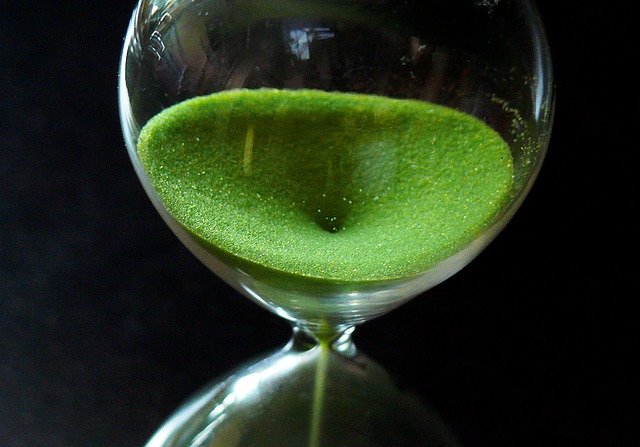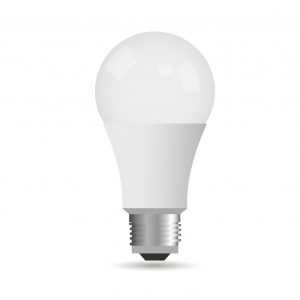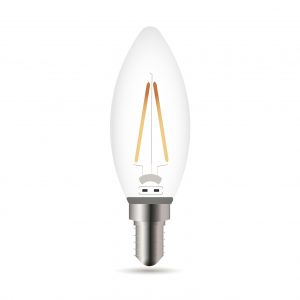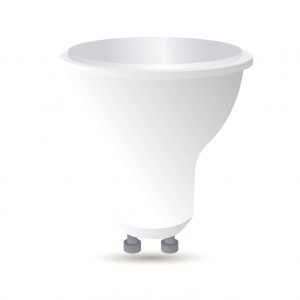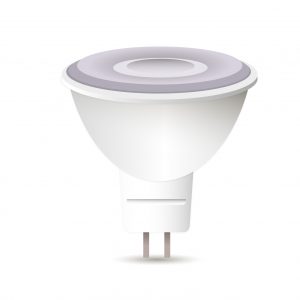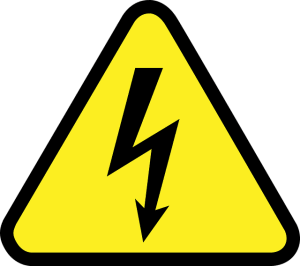Prepare to be dazzled as I take you through the fascinating world of Light Emitting Diodes. LEDs are lighting up our homes, offices, retail spaces, and streets and quickly gaining popularity.
And all for a good reason. They are costing you 1/10th of other bulbs’ running costs, thus bringing down carbon emissions by metric tons annually. They are as efficient as any technology can get by converting every trickle of power into luminance.
I will tell you how LEDs work, where they are commonly used, and the common types of LED bulbs. Then we will look at what terms like CRI, color temperature, and lumens mean so that you are well informed before you start your favorite LED project.
LED Simply Explained: How Does It Work?
You might know that LED stands for Light Emitting Diode, and a diode can be understood as a one-way electrical valve that allows current to flow only in one direction. That’s the direction in which light is emitted.
But did you know that the tiny little chip that emits the light is called a die?
About the size of your thumb, a sheet of dice measuring 1×2 inch contains 4,000 dice, carefully cut up, and used as individual pieces.
One LED dip contains 9 dice, and SMD may have 40 dice, and the densest and luminous, a COB (chip-on-board) would have 342 dice.
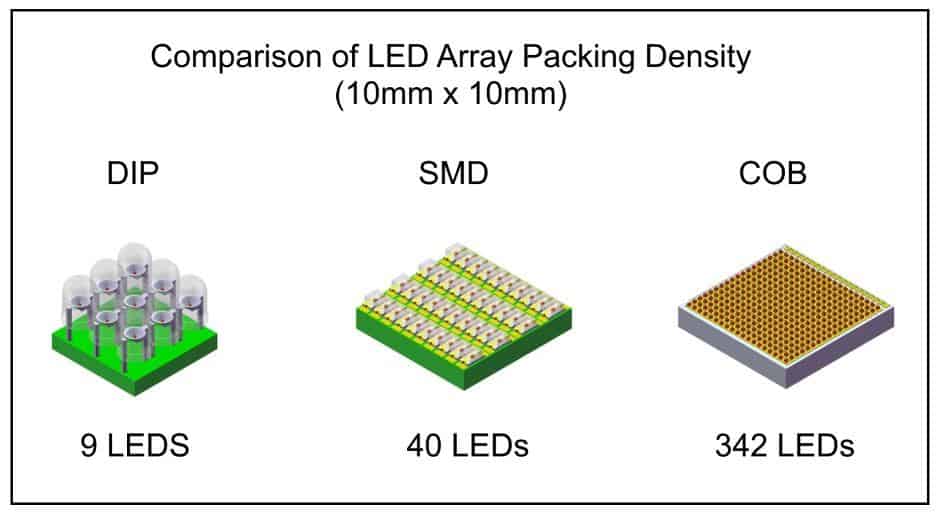
This tiny die is where the magic happens. It consists of a paper-thin semiconductor material that allows a flow of electrons from negative to positive at the p-n junction.
This material determines the photon’s wavelength that is emitted when an electron goes from ‘excited’ to a ‘grounded’ state. And if you remember your chemistry class, this wavelength indicates the visible light’s color being emitted.
What Are The Materials Used To Make LEDs?
Let’s zoom in on this fascinating piece of technology to find out what goes into making an LED.
Red and amber LEDs use the aluminum indium gallium phosphide (AlInGaP) material system. Blue, green, and cyan LEDs use the indium gallium nitride (InGaN) system.
This die is then loaded onto metal leads for contact. A gold wire is also used to bond the leads to each other.
Finally, to direct the light output towards one direction, a silicone lens is added for optics requirements. This assembly is further sealed in an epoxy resin casing that amplifies the light and adds color.
The outer body of the LED depends on the kind of light it is meant to be. A standard LED bulb’s body will be made of plastic, making it lighter to handle and cheaper to buy. Not to forget it won’t fall and break.
Designer LED bulbs are made of glass to highlight filament style design inside or make them last longer if the bulb runs on a higher voltage.
Finally, the LED is fitted with aluminium heat sinks for thermal heat management, and everything is mounted to an insulated plastic base that is cool to touch.
LED Application In Daily Life
You are quite aware of LED bulbs’ household uses as bright white kitchen lights, or moody yellow bedroom lights, or colorful, customizable living room lights. But there’s a whole lot more to the world of LED applications.
Let’s look at some of these ubiquitous yet easy to miss applications of LEDs.
Do you remember when the colors of traffic lights around your town started looking newer, brighter, and a little bit different? That’s when the city started using LEDs rather than incandescents to power traffic lights.
And just like that, there are a hundred examples of how quickly LEDs are replacing other bulb types, including halogens and CFLs. And this list is expanding every year.
They are commonly used as the backlight in TVs and smartphones, owing to their thinness allowing gadgets to be slimmer every release. The lower voltage usage also means a significantly higher battery life of smartphones.
Similarly, most advertisement signage, LED boxes, and billboards now use LEDs to brightly light up the brand’s products indoors and outdoors.
Since LEDs have very little UV radiation, retailers can protect their painted surfaces, carpets, curtains, artwork, and other textiles from fading color due to exposure to light.
Increasingly, street and urban lighting have seen an increase in LED use, thanks to LEDs having the ability to be directional and consume less power while having a long service life and a much lower carbon footprint.
More recently you can see car manufacturers opting for LED headlights, often the defining feature of newer models of cars, with their high power output and bright lights, and the flexibility to be highly directional and dimmable.
LED Light Power Consumption
You’ve heard all the rage about how LED bulbs save you money, are energy efficient and last a really long time! Well, I want to really show you exactly how high the efficiency is compared to other bulb types.
To get to that, let’s look at how much energy LEDs consume. There is an exact nit to measure power consumption called kWh, or kilowatt-hour. It tells us how much energy is used over the number of hours.
The usage of watts is measured in kilowatts (kW), so let’s say a 10 Watt LED bulb uses an average of 0.01kW. Now let’s see how many hours you use your bulb in a month.
Suppose you use it 9 hours a day, all 30 days of the month. So to get to the kWh of the bulb, we multiply by the total hours used. That is, 0.01 x 9 x 30 = 2.7 kWh is the energy consumption per month.
You can now compare this figure to other electrical appliances around the house or with other bulb types to see exactly how low this average power consumption really is.
For example, a ceiling fan uses around 15 kWh, while a freezer uses about 80 kWh over the same usage duration.
Now for the real deal. A 100 Watt incandescent bulb that outputs almost the same brightness as a 10 Watt LED (about 1600 lumens) used as an example above will use 27 kWh energy per month. Remember, an LED uses 2.7 kWh.
If you’d like, I can translate this into monthly costs and savings for you. Yea? Okay, here we go. Say your city charges 14 cents per kWh.
An incandescent would cost $3.78, while an LED would cost you 38 cents per month.
An average home has 40 bulbs! That means $151 per month of running 40 100 Watts bulbs for 9 hours every day of the month, while only $15 does the same with LED bulbs.
Well, I’ll do you one more.
Check out my yearly savings calculator, where you can customize the number of bulbs, your city’s cost of electricity, and all that jazz. Tell me in the comments how much your hypothetical savings come out to, I’m very interested to know.
How Long Do LED Lights Last?
LED technology is rapidly evolving and becoming more and more standardized with its testing, regulations, and longevity claims.
Today, LED bulbs are found that have an Average Rated Lifetime of 25,000 hours. LED strips can last for even longer, up to 40,000 hours. At the very minimum, LEDs can last for about 20,000 hours.
LEDs are a new way to illuminate a space and use a completely different electrical design to do that. Unlike LEDs, incandescents have always had a weak point, literally. The few microns-thin filament reaches hundreds of degrees in temperature and outputs tens of watts of power.
LEDs are neither held back by filaments nor by harmful argon gas as in CFLs. Instead, they are a solid-state lighting application that has no moving parts that can vibrate and fail.
Similarly, LEDs do not produce as much heat that wears down parts and weakens the sensitive circuitry inside. Most tests show that the surface of the bulb’s body is only about 85°F or 30°C.
Nevertheless, aluminum heatsinks and silicone thermal components are built into LEDs that carry heat away from the LED chips and dissipate it into flowing air.
However, keep in mind apart from the diode, an LED consists of the bulb casing, the transformers and capacitors, the lighting fixture, and the wiring and housing that goes around the luminaire.
You can see a lot of critical points exist that count towards an LED’s lifespan. Users may find a difference in the stated and actual lifespan due to these various external components.
The US Department of Energy’s Lifetime and Reliability Factsheet finds that LED chips themselves only account for 10% of the causes of failure; the majority of causes lies in the failure of driver circuitry and power supply.
Once these catch up in standards to the LED’s efficiency, your LED bulb can last for decades. It has the potential to become a family heirloom, passed down through generations!
Also read: The Definitive Guide To LED Strip Lighting
LED Fixture Types Explained
LEDs don’t just come as sleek strip lights or as a standard E26 bulb. There is a world of LED bulb types and applications, both in commercial and household usage. For now, I’ll take you through the different LEDs you may want to install in your home.
Spotlights are small lights fixed into the ceiling that output a narrow beam angle with a sharp cutoff. They may be recessed and fixed or hanging outside and adjustable with their direction of light.
Spotlights’ purpose is to highlight spots in the room or garden for dramatic effect and enhancing objects. Their focused light allows beautiful mood lighting setups, emphasizing an interesting painting or bringing attention to the tree in the front lawn.
Downlights are also recessed lights installed into the ceiling, but they are almost double the spotlights and throw a much more diffused light with a wide beam angle. Therefore, they are usually the main general-purpose or auxiliary lighting of the room they are used in.
Downlights will clearly light up large areas like corridors, kitchens, and bathrooms and are best for practical purposes. They cause minimal shadows or glare.
Floodlights are a great way to brightly light up a very large area, traditionally used outdoors, but with LEDs, now commonly used indoors. One floodlight can comfortably flood a whole garage with light, or two will flood the entire front of the house if you use it as a security light.
It comes as an independent unit that can be moved around and plugged as your requirements, with an inbuilt heatsink, transformer, and power supply unit.
Integrated LEDs are all the new rage, becoming a fan favorite. These lighting units have an inbuilt array of LEDs that cannot be accessed by the user. They come in various modern and sophisticated designs, like designer ceiling panels or beautiful wall-mounted sconces.
Integrated LEDs are often backed by good warranties of replacement and repair and are built to last for much longer than bulbs. If your built-in LED array goes bad, your option would be to change the fixture or call in that repair warranty.
Smart LED bulbs are the most versatile and no brainer lighting system that you can get your hands on. With the range of functionality and programmability, smart bulbs can change your daily routine for good.
Smart bulbs come with a microchip that stays on standby, waiting for inputs from your mobile app, your digital voice assistant like Alexa, or other devices, through the home’s WiFi network.
They change colors according to the task at hand, or automatically get dimmer towards the late evening, and can wake up before you to wake you up!
Types of LED Fittings at Home
LED bulbs are now available in a wide variety of types that can be used in any of the fixtures you may have.
Let me take you through some of the most common ones that may be used around the house, and you will likely end up buying!
E27 – The E27 bulb refers to the standard screw type Edison bulb with a diameter of 27mm. This is most commonly used and is also called A-19. These long-lasting energy-saving bulbs are output between 400-800 lumens, while the wattage ranges from 4-8 watts.
E26 – The E26 is almost precisely like the E27, just smaller by a millimeter, and both are interchangeable if universally rated. Usually, an E26 is the American standard and runs on 120 Volts, while the E27 is the European standard, rated at 220 Volts.
E14 – The E14 bulb is the candelabra bulb’s common name that is shaped like a flame and used in decorative lamps and chandeliers. They emit a soft glow to create the effect of a candle-lit dinner and look very charming. Technically, E14 refers to the base’s shape, which is screw-type and 14 mm wide, and can come in the globe and arbitrary shapes too.
GU10 – The GU10 bulbs are nifty little lights used in spotlights in homes, offices, and shops. They are very low profile, with a flat lens at the top and two small pronged connectors, and can quickly plug in with a twist. They come in 3-5 watts and give an angled light beam with sharp cutoffs. They’re the perfect LEDs for bringing focus to artwork or decor.
Also read: How To Remove G9 Light Bulb Stuck In Socket?
GU5.3 – A GU5.3 is similar in function to the GU10 bulb, highlighting spotlight, with 2 differences. First, as you can tell by the code, the GU5.3 base is about half the width of the GU10. The GU5.3 uses a pin-type, push-to-fit base. Secondly, the GU5.3 is rated for 12 V and does not directly plug into mains without a transformer.
G4 – You would think these are the tiniest lights you can buy. The G4 LED is a small capsule of diodes that push-fit into overhead appliance sockets, individual table lamps, and highly decorative chandeliers. They are meant to replace bright small halogen bulbs and usually are rated at 3 watts. They only run on 12 V circuits.
What You Should Know About Dimming and LED Lights?
Usually, old dimmers and LEDs don’t get along very well. Let me explain.
LED tech functions in binary computational on/off state. You should try to understand that an LED is more like computer technology. And just like computers, LEDs run on low-voltage DC current, such as 12 Volts.
On the flip side, older dimmers worked with incandescents requiring high-voltage AC current, say 240 Volts.
This mismatch between new low-voltage LEDs plugged into old, high-voltage dimmers results in various issues, including buzzing and humming from the switches or bulbs.
An incompatible dimmer switch wired to a newer LED fixture or the bulb will produce a humming sound as it turns on/off at irregular intervals, indicating electromagnetic interference (EMI).
To dim, a dimmer evenly changes the voltage going into an incandescent bulb. An LED bulb cannot respond to that gradual change in voltage and flickers or buzzes.
The solid-state power supply makes the buzz.
You can always buy newer LED compatible dimmer switches, along with dimmable LEDs. Even then, you may hear a slight humming, but it is not discernible.
Most dimmers will always hum if you listen closely, whether with LEDs or with incandescents. Manufacturers do not count it as humming if you cannot hear it from 2 feet away.
Measuring the LED Efficiency: Watts and Lumens
We like to get our money’s worth out of a purchase. The more value for the same price, the better we feel.
So why not get the most brightness out of your LEDs while keeping the costs down as much as possible.
The amount of brightness that is output based on the input power will give us the efficiency of a light bulb. Lumens is the correct term to refer to the brightness, and watts refers to the rated power the bulb is meant to use.
It is measured in lumens per watt and calculated using Efficiency=Lumens/Watts.
Higher efficiency means more lumens for fewer watts, and the higher the number, the better the efficiency compared to other bulbs.
LEDs are highly efficient pieces of electronics. The once commonly used 60-watt incandescent bulb outputs around 800 lumens, which would light up a small bathroom.
In LEDs, the equivalent wattage needed to output 800 lumens is just 6 watts, give or take. The lower the watts used, the lower your electricity bills.
By changing your incandescents for LEDs, your bill will come down to 1/10th the amount. Let that sink in.
What is CRI And Why Does It Matter?
Many factors result in a high-quality LED bulb. I am here to take you through the most vital ones. One such crucial photometric specification to look out for is CRI, or color rendering index.
This is reading between 1-100 of the accuracy of the colors being rendered under the bulb in question, where 100 is the sun’s CRI, and so is 100% accurate.
A low reading can make your room’s colors look dull and washed out, while a high reading in the 90’s range shows the accurate color of the object. For photographers, art enthusiasts, and makeup artists, this reading becomes critical.
For household use, a minimum CRI of 80 will serve your purposes well. Anything below 70, and you will feel the room feel tinted and unnatural.
Color Temperature Explained
Let’s talk about the next vital photometric specification you should be watching out for. I am sure you have come across this before. The correlated color temperature (CCT) of a bulb is the coolness/warmth measure of white light being output, measured in Kelvins.
The scale goes from a warm, yellow-colored light measuring around 2000 Kelvins, all the way up to 6000 Kelvins, which is a cool, bluish light. The CCT rating is essential to know so you can use the lights in the appropriate location.
For example, a place that needs to be focused, detail-oriented work such as the kitchen counter or a garage table would be great with a 3,500-5,000 Kelvin CCT LED.
On the other hand, a relaxing evening lounge or a bedroom will feel cozier with warm lights rated at 2,000-3,000 Kelvin.
Keep in mind that the color temperature of a light does not determine the brightness of the light. A cool light can be dim, while a warm light can be bright. Brightness is a separate measure, rated in Lumens.
LED Light Hazards
Have you heard of a thing such as lesser evils? That’s when every alternate around is much worse, so you settle for the thing that causes the least harm.
Not without its flaws, LEDs cause the least harm out of all the bulb types. While I have told you many of LEDs’ qualities, let me walk you through some of the perceived and some of the LED lights’ actual hazards. Spoiler alert: there is only one confirmed health effect.
Let me address that first. LEDs are a major source of what medical experts call ‘blue light.’
While LEDs can emit a range of colors, it is the blue light emitted by LEDs used in computer monitors, the screen of phones, TV, tablets, and so on.
And these are ever-present at our fingertips not just throughout the day, but more damagingly, through the evening and night. When our eyes are exposed to blue light, our bodies stop producing melatonin.
When misused, LEDs can also cause fires in rare occurrences due to overheating. For example, poorly constructed festive string lights are small LEDs bunched closely together and wrapped around flammable material, like Christmas trees.
Luckily, these occurrences are relatively rare.
And of course, using a higher wattage LED in a fixture that allows only lower wattage, or using incorrect voltage LEDs, such as a 12V bulb in a 120V line, can all lead to serious electrical hazards.
Frequently Asked Questions
I have walked you through how an LED works and the most important specifications to watch out for. Now let’s quickly look at some frequently asked questions about LEDs. If you don’t see your question below, write me a comment, and I will get you the answer.
Are LED Lights Good For Reading?
Cool-white LEDs give off some blue light that might be detrimental to eye health for developing kids and teenagers when exposed for very long periods.
You can choose a more natural warm white color LED, with a comfortable brightness and a high CRI, to achieve the best ambient reading light.
Do LED Lights Really Last 50,000 Hours?
I want you to be a bit critical in that section because 50k is an unrealistic claim. Often it is not the case, so be a bit careful with that question, saying that yes, in theory, but all the various conditions affect that, so practically, it is almost impossible.
Theoretically, LEDs can last 50,000 hours as per laboratory testing and standards. Many LEDs have the potential to do so when the best components are used within the bulbs.
However, it is very difficult at homes and offices to maintain the ideal conditions to run LEDs. Either heat, excessive electrical stress, or voltage fluctuations can affect an LED’s optimal performance.
When the bulb does prematurely fail, the diode is not the one that usually fails; it is auxiliary parts. So we settle for the next best thing. Which is still thousands of more hours of life compared to incandescent and CFLs.
Is It Safe To Leave LED Lights On 24/7?
If you bought quality products, then you can certainly leave LEDs on 24/7. LEDs with high standards of testing and components are built to last thousands of hours. Good LEDs come with built-in heat dissipation heat sinks that don’t let them get too hot to operate.
It is still a good practice to first test out the LED by leaving it on for an extended period while you are around and seeing any effects, like heating up.
But is it safe for the environment to leave any lights on when not in use, despite how little energy they consume?
Certainly not, and you still need to account for the light pollution, which becomes a bigger and bigger problem.
Do LED Bulbs Work In Incandescent Fixtures?
LEDs can work in incandescent fixtures as long as a few things are out of the way. First, the fixture should not be enclosed for allowing heat dissipation unless you are using enclosed rated LEDs!
Secondly, the fixture should not be dimmable. Otherwise, the LEDs may be incompatible and end up flickering.
Lastly, physically the LED needs to be able to fit. So the base and socket need to match up. Your LED’s size needs to be small enough to fit into the fixture, as LEDs may be a bit bigger than other bulbs.
Final Words
I hope you had as much reading the comprehensive guide about LED lighting as I had in writing about it! There is so much to discover and learn and so much room to keep adapting technology for higher and higher efficiency.
Not only do they cut your energy costs, but they are also cutting down the carbon footprint all around the world. By simply changing your lighting to LED, you can save the planet.
Share with me what you have learned about LEDs and more you would like to read about.
Your lighting guy.
Looking for an LED bulb but not sure what type you need?
Check out my free bulb picker and select the right bulb within few clicks.

